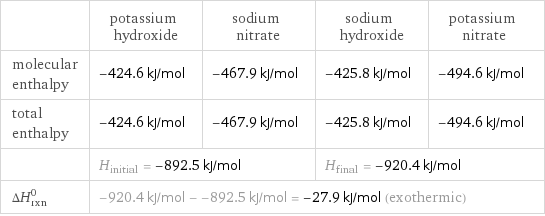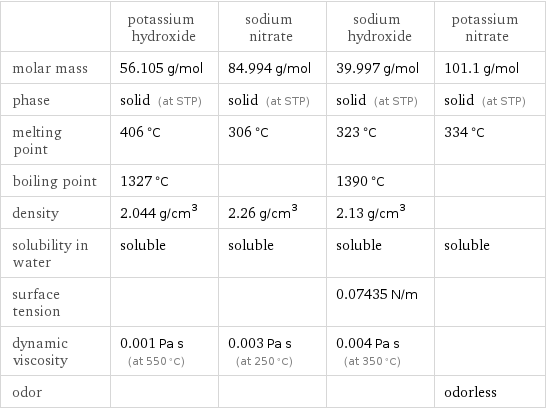Input interpretation

KOH potassium hydroxide + NaNO_3 sodium nitrate ⟶ NaOH sodium hydroxide + KNO_3 potassium nitrate
Balanced equation

Balance the chemical equation algebraically: KOH + NaNO_3 ⟶ NaOH + KNO_3 Add stoichiometric coefficients, c_i, to the reactants and products: c_1 KOH + c_2 NaNO_3 ⟶ c_3 NaOH + c_4 KNO_3 Set the number of atoms in the reactants equal to the number of atoms in the products for H, K, O, N and Na: H: | c_1 = c_3 K: | c_1 = c_4 O: | c_1 + 3 c_2 = c_3 + 3 c_4 N: | c_2 = c_4 Na: | c_2 = c_3 Since the coefficients are relative quantities and underdetermined, choose a coefficient to set arbitrarily. To keep the coefficients small, the arbitrary value is ordinarily one. For instance, set c_1 = 1 and solve the system of equations for the remaining coefficients: c_1 = 1 c_2 = 1 c_3 = 1 c_4 = 1 Substitute the coefficients into the chemical reaction to obtain the balanced equation: Answer: | | KOH + NaNO_3 ⟶ NaOH + KNO_3
Structures

+ ⟶ +
Names

potassium hydroxide + sodium nitrate ⟶ sodium hydroxide + potassium nitrate
Reaction thermodynamics
Enthalpy

| potassium hydroxide | sodium nitrate | sodium hydroxide | potassium nitrate molecular enthalpy | -424.6 kJ/mol | -467.9 kJ/mol | -425.8 kJ/mol | -494.6 kJ/mol total enthalpy | -424.6 kJ/mol | -467.9 kJ/mol | -425.8 kJ/mol | -494.6 kJ/mol | H_initial = -892.5 kJ/mol | | H_final = -920.4 kJ/mol | ΔH_rxn^0 | -920.4 kJ/mol - -892.5 kJ/mol = -27.9 kJ/mol (exothermic) | | |
Gibbs free energy

| potassium hydroxide | sodium nitrate | sodium hydroxide | potassium nitrate molecular free energy | -379.4 kJ/mol | -366 kJ/mol | -379.7 kJ/mol | -394.9 kJ/mol total free energy | -379.4 kJ/mol | -366 kJ/mol | -379.7 kJ/mol | -394.9 kJ/mol | G_initial = -745.4 kJ/mol | | G_final = -774.6 kJ/mol | ΔG_rxn^0 | -774.6 kJ/mol - -745.4 kJ/mol = -29.2 kJ/mol (exergonic) | | |
Equilibrium constant
![Construct the equilibrium constant, K, expression for: KOH + NaNO_3 ⟶ NaOH + KNO_3 Plan: • Balance the chemical equation. • Determine the stoichiometric numbers. • Assemble the activity expression for each chemical species. • Use the activity expressions to build the equilibrium constant expression. Write the balanced chemical equation: KOH + NaNO_3 ⟶ NaOH + KNO_3 Assign stoichiometric numbers, ν_i, using the stoichiometric coefficients, c_i, from the balanced chemical equation in the following manner: ν_i = -c_i for reactants and ν_i = c_i for products: chemical species | c_i | ν_i KOH | 1 | -1 NaNO_3 | 1 | -1 NaOH | 1 | 1 KNO_3 | 1 | 1 Assemble the activity expressions accounting for the state of matter and ν_i: chemical species | c_i | ν_i | activity expression KOH | 1 | -1 | ([KOH])^(-1) NaNO_3 | 1 | -1 | ([NaNO3])^(-1) NaOH | 1 | 1 | [NaOH] KNO_3 | 1 | 1 | [KNO3] The equilibrium constant symbol in the concentration basis is: K_c Mulitply the activity expressions to arrive at the K_c expression: Answer: | | K_c = ([KOH])^(-1) ([NaNO3])^(-1) [NaOH] [KNO3] = ([NaOH] [KNO3])/([KOH] [NaNO3])](../image_source/88e58902b5a29d984c2dcfa06e723c63.png)
Construct the equilibrium constant, K, expression for: KOH + NaNO_3 ⟶ NaOH + KNO_3 Plan: • Balance the chemical equation. • Determine the stoichiometric numbers. • Assemble the activity expression for each chemical species. • Use the activity expressions to build the equilibrium constant expression. Write the balanced chemical equation: KOH + NaNO_3 ⟶ NaOH + KNO_3 Assign stoichiometric numbers, ν_i, using the stoichiometric coefficients, c_i, from the balanced chemical equation in the following manner: ν_i = -c_i for reactants and ν_i = c_i for products: chemical species | c_i | ν_i KOH | 1 | -1 NaNO_3 | 1 | -1 NaOH | 1 | 1 KNO_3 | 1 | 1 Assemble the activity expressions accounting for the state of matter and ν_i: chemical species | c_i | ν_i | activity expression KOH | 1 | -1 | ([KOH])^(-1) NaNO_3 | 1 | -1 | ([NaNO3])^(-1) NaOH | 1 | 1 | [NaOH] KNO_3 | 1 | 1 | [KNO3] The equilibrium constant symbol in the concentration basis is: K_c Mulitply the activity expressions to arrive at the K_c expression: Answer: | | K_c = ([KOH])^(-1) ([NaNO3])^(-1) [NaOH] [KNO3] = ([NaOH] [KNO3])/([KOH] [NaNO3])
Rate of reaction
![Construct the rate of reaction expression for: KOH + NaNO_3 ⟶ NaOH + KNO_3 Plan: • Balance the chemical equation. • Determine the stoichiometric numbers. • Assemble the rate term for each chemical species. • Write the rate of reaction expression. Write the balanced chemical equation: KOH + NaNO_3 ⟶ NaOH + KNO_3 Assign stoichiometric numbers, ν_i, using the stoichiometric coefficients, c_i, from the balanced chemical equation in the following manner: ν_i = -c_i for reactants and ν_i = c_i for products: chemical species | c_i | ν_i KOH | 1 | -1 NaNO_3 | 1 | -1 NaOH | 1 | 1 KNO_3 | 1 | 1 The rate term for each chemical species, B_i, is 1/ν_i(Δ[B_i])/(Δt) where [B_i] is the amount concentration and t is time: chemical species | c_i | ν_i | rate term KOH | 1 | -1 | -(Δ[KOH])/(Δt) NaNO_3 | 1 | -1 | -(Δ[NaNO3])/(Δt) NaOH | 1 | 1 | (Δ[NaOH])/(Δt) KNO_3 | 1 | 1 | (Δ[KNO3])/(Δt) (for infinitesimal rate of change, replace Δ with d) Set the rate terms equal to each other to arrive at the rate expression: Answer: | | rate = -(Δ[KOH])/(Δt) = -(Δ[NaNO3])/(Δt) = (Δ[NaOH])/(Δt) = (Δ[KNO3])/(Δt) (assuming constant volume and no accumulation of intermediates or side products)](../image_source/a838b35f8c9fa2e9ae12787f57444bf5.png)
Construct the rate of reaction expression for: KOH + NaNO_3 ⟶ NaOH + KNO_3 Plan: • Balance the chemical equation. • Determine the stoichiometric numbers. • Assemble the rate term for each chemical species. • Write the rate of reaction expression. Write the balanced chemical equation: KOH + NaNO_3 ⟶ NaOH + KNO_3 Assign stoichiometric numbers, ν_i, using the stoichiometric coefficients, c_i, from the balanced chemical equation in the following manner: ν_i = -c_i for reactants and ν_i = c_i for products: chemical species | c_i | ν_i KOH | 1 | -1 NaNO_3 | 1 | -1 NaOH | 1 | 1 KNO_3 | 1 | 1 The rate term for each chemical species, B_i, is 1/ν_i(Δ[B_i])/(Δt) where [B_i] is the amount concentration and t is time: chemical species | c_i | ν_i | rate term KOH | 1 | -1 | -(Δ[KOH])/(Δt) NaNO_3 | 1 | -1 | -(Δ[NaNO3])/(Δt) NaOH | 1 | 1 | (Δ[NaOH])/(Δt) KNO_3 | 1 | 1 | (Δ[KNO3])/(Δt) (for infinitesimal rate of change, replace Δ with d) Set the rate terms equal to each other to arrive at the rate expression: Answer: | | rate = -(Δ[KOH])/(Δt) = -(Δ[NaNO3])/(Δt) = (Δ[NaOH])/(Δt) = (Δ[KNO3])/(Δt) (assuming constant volume and no accumulation of intermediates or side products)
Chemical names and formulas

| potassium hydroxide | sodium nitrate | sodium hydroxide | potassium nitrate formula | KOH | NaNO_3 | NaOH | KNO_3 Hill formula | HKO | NNaO_3 | HNaO | KNO_3 name | potassium hydroxide | sodium nitrate | sodium hydroxide | potassium nitrate
Substance properties

| potassium hydroxide | sodium nitrate | sodium hydroxide | potassium nitrate molar mass | 56.105 g/mol | 84.994 g/mol | 39.997 g/mol | 101.1 g/mol phase | solid (at STP) | solid (at STP) | solid (at STP) | solid (at STP) melting point | 406 °C | 306 °C | 323 °C | 334 °C boiling point | 1327 °C | | 1390 °C | density | 2.044 g/cm^3 | 2.26 g/cm^3 | 2.13 g/cm^3 | solubility in water | soluble | soluble | soluble | soluble surface tension | | | 0.07435 N/m | dynamic viscosity | 0.001 Pa s (at 550 °C) | 0.003 Pa s (at 250 °C) | 0.004 Pa s (at 350 °C) | odor | | | | odorless
Units
